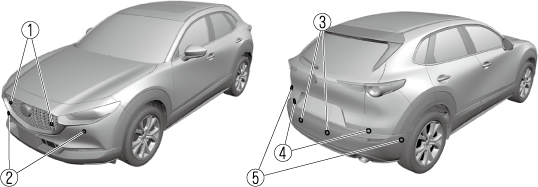

Parking Sensor System
The parking sensors use ultrasonic sensors which detect obstructions around the vehicle when the vehicle is driven at low speeds, such as during garage or parallel parking, and a buzzer sound and detection indicator notify the driver of the approximate distance from the vehicle to the surrounding obstruction.

-
Front ultrasonic sensor (Some Models)
-
Front corner ultrasonic sensor (Some Models)
-
Rear ultrasonic sensor
-
Rear corner ultrasonic sensor
-
Rear side ultrasonic sensor (Some Models)
Do not rely completely on the parking sensor system and be sure to confirm the safety around your vehicle visually when driving:
This system can assist the driver in operating the vehicle in the forward and backward directions while parking. The detection ranges of the sensors are limited, therefore, driving the vehicle while relying only on the system may cause an accident. Always confirm the safety around your vehicle visually when driving.
-
Do not install any accessories within the detection ranges of the sensors. It may affect the system operation.
-
Depending on the type of obstruction and the surrounding conditions, the detection range of a sensor may narrow, or the sensors may not be able to detect obstructions.
-
When the ignition is switched OFF, the system status before it was turned off is maintained. For example, if the ignition is switched OFF while the parking sensor is activated, the system will be activated when the ignition is switched ON the next time.
-
The system may not operate normally under the following conditions:
-
Mud, ice, or snow is adhering to the sensor area (Returns to normal operation when removed).
-
The sensor area is frozen (Returns to normal operation when the ice is thawed).
-
The sensor is covered by a hand.
-
The sensor is excessively shocked.
-
The vehicle is excessively tilted.
-
Under extremely hot or cold weather conditions.
-
The vehicle is driven on bumps, inclines, gravel, grating, or grass covered roads.
-
Anything which generates ultrasonic waves such as another vehicle's horn, the engine sound of a motorcycle, the air brake sound of a large-sized vehicle, or another vehicle's sensors approaches the vehicle.
-
The vehicle is driven in heavy rain or in road conditions causing water-splash.
-
A commercially-available fender pole or an antenna for a radio transmitter is installed to the vehicle.
-
The vehicle is moving towards a tall or square curbstone, or a steep grade.
-
An obstruction is too close to the sensor.
-
The vehicle is moving towards an uneven wall or stairs.
-
There are multiple obstructions.
-
The vehicle is driven in a place with low ceilings.
-
-
Obstructions under the bumper cannot be detected. Obstructions which are lower than the sensor or thin may not be detected even though they were detected once.
-
The following types of obstructions may not be detected:
-
Thin objects such as wire, rope or poles
-
Things which absorb sonic waves easily such as cotton or snow
-
Angular shaped objects
-
Very tall objects, and those which are wide at the top
-
Small, short objects
-
-
Always have the system inspected at an Authorized Mazda Dealer if any shock is applied to the bumpers, even in a minor accident. If the sensors are deviated, they cannot detect obstructions.
-
The system may have a malfunction if a sound is not activated or the detection indication is not displayed even when the parking sensor OFF switch is pressed and the parking sensor is operable. Have your vehicle inspected by an Authorized Mazda Dealer.
-
The system may have a malfunction if the indicator light does not turn on even when the parking sensor OFF switch is turned on. Have your vehicle inspected by an Authorized Mazda Dealer.
-
The system may have a malfunction if a message indicating a system malfunction is displayed. Have your vehicle inspected by an Authorized Mazda Dealer.
-
A message may be displayed even when the ambient temperature is extremely cold, or mud, ice, or snow adheres to the sensor area. Remove any foreign matter from the sensor area.


